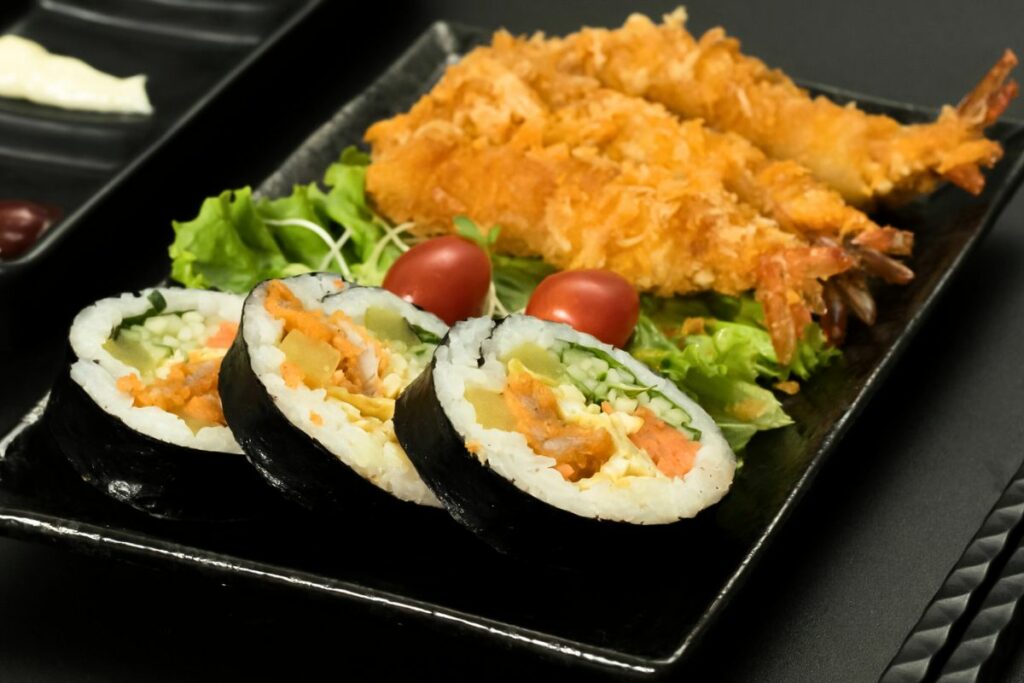Sushi is a popular Japanese cuisine that has gained immense popularity all over the world. It is a dish that is enjoyed by people of all ages and backgrounds. However, if you are new to sushi, you might be wondering what to serve with it. The good news is that there are plenty of side dishes that can complement the flavors of sushi.
One of the most popular side dishes to serve with sushi is miso soup. This soup is made from fermented soybeans and has a rich, savory flavor that pairs well with sushi. Another popular side dish is edamame, which are salted, boiled soybeans that are served in their pods. They are a great source of protein and are a healthy snack to munch on while enjoying your sushi.
In addition to miso soup and edamame, there are many other side dishes that can be served with sushi. These include pickled ginger, seaweed salad, tempura, and gyoza dumplings. Each of these side dishes has a unique flavor profile that can enhance the taste of your sushi. Whether you are a sushi enthusiast or a first-time eater, incorporating these side dishes into your meal can take your sushi experience to the next level.
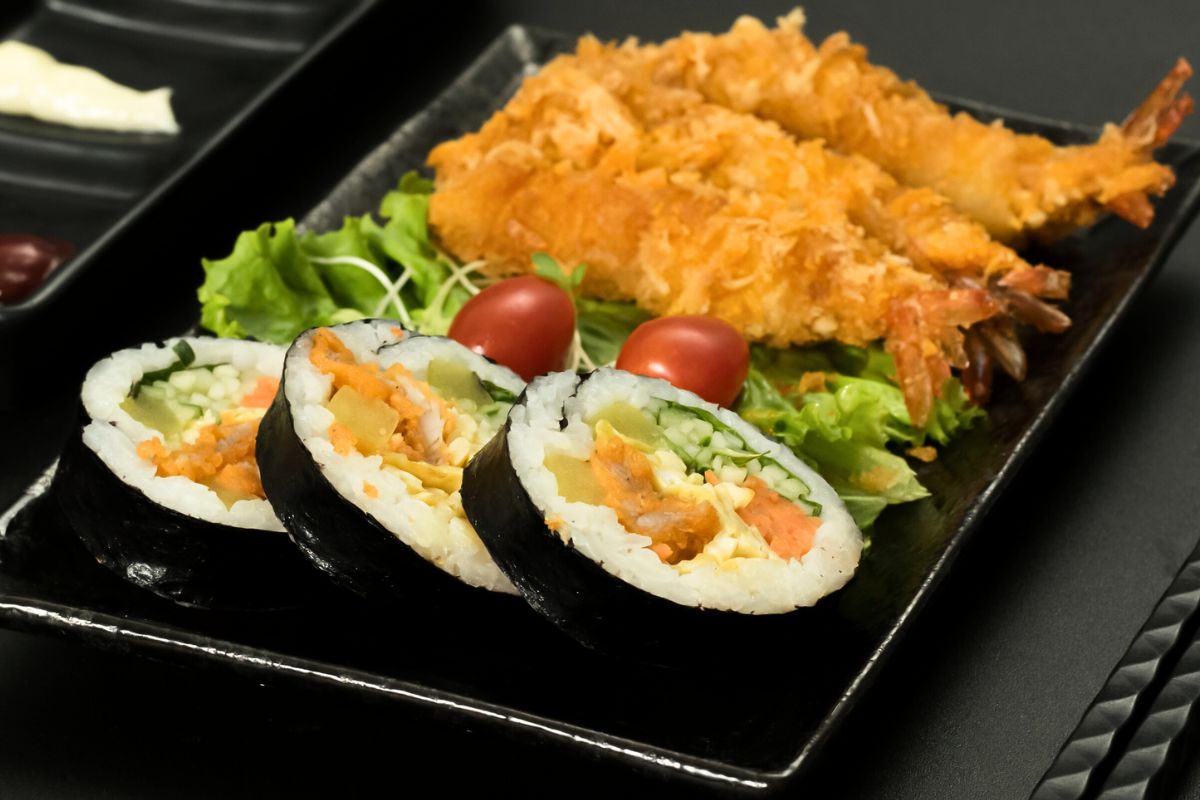
Contents
- 1 Understanding Sushi
- 2 Essential Sushi Condiments
- 3 Popular Sushi Side Dishes
- 4 The Role of Vegetables in Sushi Meals
- 5 Savoring Seafood Options
- 6 The Importance of Rice
- 7 The Art of Japanese Soups
- 8 Exploring Japanese Beverages
- 9 The Sweet Side of Sushi Meals
- 10 Creating Balanced Flavors
- 11 The Use of Tofu in Sushi Meals
- 12 The Role of Eggs in Sushi
- 13 Exploring Japanese-Inspired Recipes
- 14 The Importance of Freshness
Understanding Sushi
Sushi is a popular Japanese dish that has become a favorite of many people around the world. It is a dish that is typically made with vinegared rice, raw fish, and other ingredients such as vegetables, seaweed, and egg. Sushi can be enjoyed in different forms, including nigiri and sushi rolls.
Nigiri is a type of sushi that consists of a small ball of vinegared rice topped with a slice of raw fish. The most common types of fish used for nigiri are salmon, ahi, and ebi. Nigiri can also be made with other types of seafood, such as unagi (eel).
Sushi rolls, on the other hand, are made by wrapping vinegared rice and other ingredients in seaweed. The most popular type of sushi roll is the California roll, which typically contains crab meat, avocado, and cucumber. Other popular sushi rolls include the spicy tuna roll and the dragon roll.
When it comes to serving sushi, it is important to understand the different flavors and textures of the dish. Sushi is typically served with soy sauce, wasabi, and pickled ginger. Soy sauce is used to enhance the flavor of the sushi, while wasabi is used to add a spicy kick. Pickled ginger is often eaten between different types of sushi to cleanse the palate.
It is also important to note that sushi is typically made with raw fish. While raw fish can be safe to eat, it is important to ensure that it is fresh and has been handled properly. If you are unsure about the freshness of the fish, it is best to avoid it.
In conclusion, sushi is a delicious and popular Japanese dish that can be enjoyed in different forms. Whether you prefer nigiri or sushi rolls, it is important to understand the different flavors and textures of the dish. Sushi should be enjoyed with soy sauce, wasabi, and pickled ginger, and it is important to ensure that any raw fish used in the dish is fresh and has been handled properly.
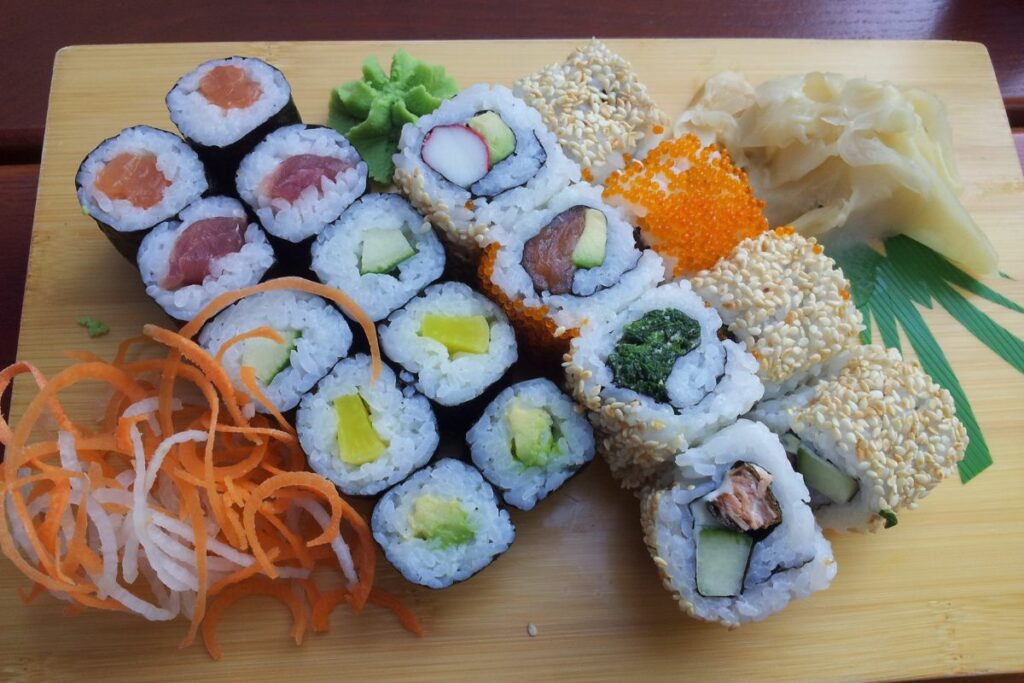
Essential Sushi Condiments
When it comes to sushi, condiments are just as important as the fish and rice. They add flavor, texture, and depth to the overall sushi experience. Here are some essential sushi condiments that every sushi lover should know:
Soy Sauce
Soy sauce is a staple condiment in Japanese cuisine, and it’s no different when it comes to sushi. It’s used for dipping sushi rolls, sashimi, and other dishes. Traditional soy sauce is somewhat salty but has a strong flavor, while Ponzu is a citrusy-flavored soy sauce that is also used for dipping. There are also low-sodium soy sauce options available for those who are watching their salt intake.
Wasabi
Wasabi is a green paste that is made from the root of the wasabi plant. It has a pungent, spicy flavor that pairs well with sushi. Wasabi is usually served in small amounts, and it’s important to use it sparingly as it can be quite potent. Some sushi restaurants also serve a mix of wasabi and soy sauce called “wasabi-joyu.”
Gari
Gari, or pickled ginger, is a palate cleanser that is served with sushi. It’s made from thinly sliced young ginger that has been pickled in vinegar and sugar. Gari helps to cleanse the palate between bites of sushi, allowing you to fully appreciate the flavors of each piece.

Japanese Mayo
Japanese mayo is a creamy, tangy mayonnaise that is used as a condiment in many Japanese dishes, including sushi. It’s made with rice vinegar, egg yolks, and a touch of MSG. Japanese mayo is often used in sushi rolls, as it adds a creamy texture and tangy flavor.
Dipping Sauce
Dipping sauce is a common condiment for sushi rolls. It’s usually made with soy sauce, rice vinegar, and mirin. Some sushi restaurants also add a touch of sugar and sake to the dipping sauce for added depth of flavor.
In conclusion, these essential sushi condiments are a must-have for any sushi lover. They add flavor, texture, and depth to the overall sushi experience, making it even more enjoyable. Whether you prefer traditional soy sauce, wasabi, gari, Japanese mayo, or dipping sauce, these condiments are sure to enhance your sushi experience.
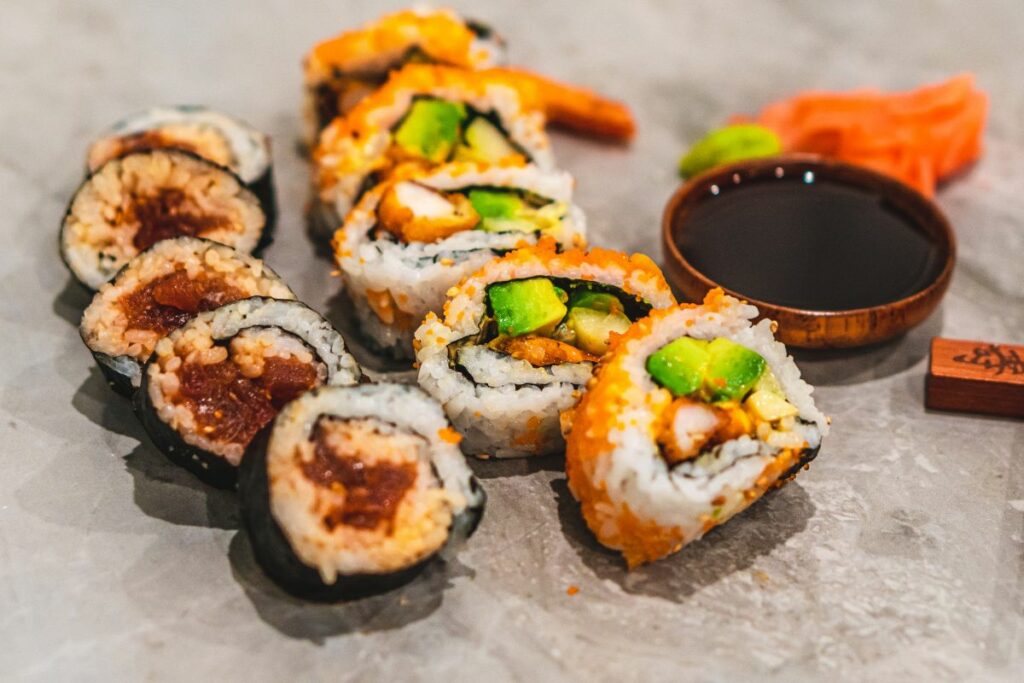
Popular Sushi Side Dishes
Sushi is a popular Japanese dish that has become a favorite among many people around the world. It is usually served with a variety of side dishes that complement its flavors and textures. Here are some popular sushi side dishes that you can serve with your sushi:
Miso Soup
Miso soup is a traditional Japanese soup made from miso paste and dashi stock. It has a savory and slightly salty taste that complements the flavors of sushi. Miso soup is usually served in small bowls and can be enjoyed as a starter or alongside sushi.
Tempura
Tempura is a popular Japanese dish that consists of battered and deep-fried seafood or vegetables. It is a perfect side dish for sushi because it adds a crunchy texture and a savory taste that complements the soft and delicate flavors of sushi. Some popular tempura dishes that you can serve with sushi include shrimp tempura, vegetable tempura, and crab rangoon.
Seaweed Salad
Seaweed salad is a refreshing and healthy side dish that is commonly served with sushi. It is made from various types of seaweed that are seasoned with vinegar, soy sauce, and sesame oil. Seaweed salad adds a crunchy texture and a slightly sweet and sour taste that complements the flavors of sushi.
Kani Salad
Kani salad is a Japanese crab salad that is made from imitation crab meat, cucumber, and mayonnaise. It is a light and refreshing side dish that complements the flavors of sushi. Kani salad adds a creamy texture and a slightly sweet and tangy taste that enhances the flavors of sushi.

Gyoza
Gyoza is a popular Japanese dumpling that is usually filled with ground meat or vegetables. It is a perfect side dish for sushi because it adds a savory taste and a chewy texture that complements the soft and delicate flavors of sushi. Some popular gyoza dishes that you can serve with sushi include pork gyoza, chicken gyoza, and vegetable gyoza.
Edamame
Edamame is a traditional Japanese snack that is made from boiled and salted soybeans. It is a healthy and delicious side dish that complements the flavors of sushi. Edamame adds a crunchy texture and a slightly salty taste that enhances the flavors of sushi.
Cucumber Salad
Cucumber salad is a refreshing and healthy side dish that is commonly served with sushi. It is made from sliced cucumbers that are seasoned with vinegar, soy sauce, and sesame oil. Cucumber salad adds a crunchy texture and a slightly sweet and sour taste that complements the flavors of sushi.
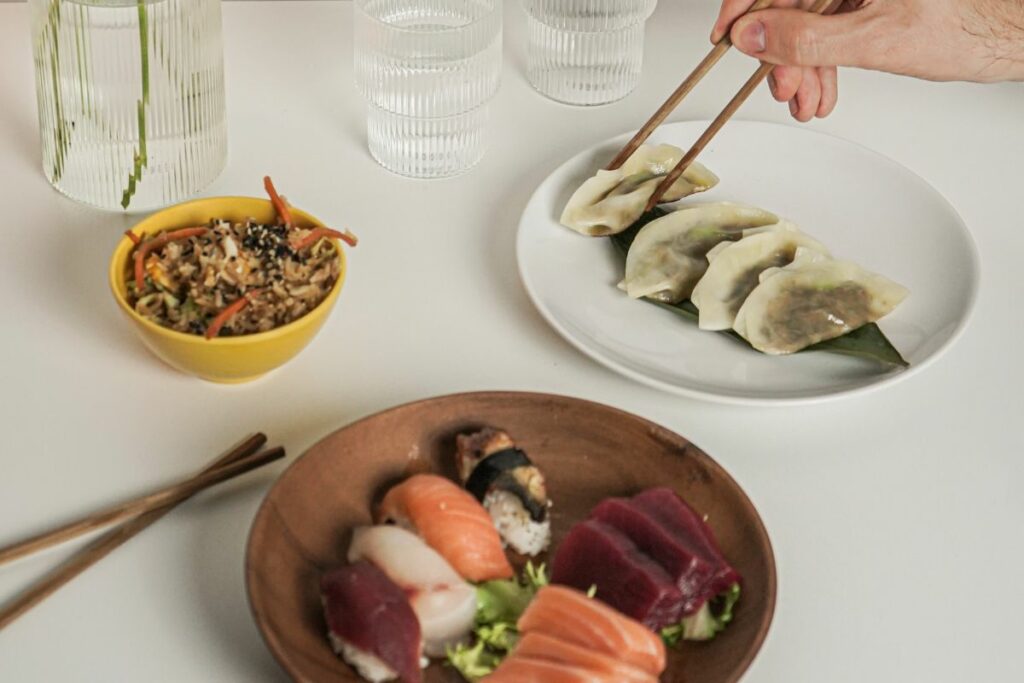
The Role of Vegetables in Sushi Meals
Vegetables play an essential role in sushi meals. They add texture, color, and flavor to the sushi rolls, making them more appealing to the eyes and taste buds. Vegetables also provide essential nutrients that help to balance the protein and carbohydrate content of the sushi.
Cucumber is one of the most popular vegetables used in sushi. It adds a refreshing crunch to the sushi rolls and complements the flavor of the fish. Cucumber is also low in calories, making it an ideal vegetable for those who want to maintain a healthy diet.
Seaweed is another vegetable that is commonly used in sushi. It is rich in iodine, which is essential for thyroid function. Seaweed also adds a unique umami flavor to the sushi rolls, making them more satisfying.
Carrots are often used in sushi rolls to add color and texture. They are also a good source of vitamin A and antioxidants, which are essential for maintaining healthy skin and eyes.
Onions are used in sushi rolls to add a sweet and tangy flavor. They are also rich in antioxidants and have anti-inflammatory properties, making them a healthy addition to any sushi meal.
Lettuce and green onions are also popular vegetables used in sushi. Lettuce adds a refreshing crunch, while green onions add a mild onion flavor. Both are low in calories and provide essential nutrients.
Cabbage is another vegetable that is commonly used in sushi. It is rich in vitamin C and antioxidants, which help to boost the immune system and protect against chronic diseases. Cabbage also adds a satisfying crunch to the sushi rolls.
Shiitake mushrooms are sometimes used in sushi rolls to add a meaty texture and umami flavor. They are also a good source of vitamin D and antioxidants, making them a healthy addition to any sushi meal.
Overall, vegetables play an important role in sushi meals. They provide essential nutrients, add flavor and texture, and help to balance the protein and carbohydrate content of the sushi.
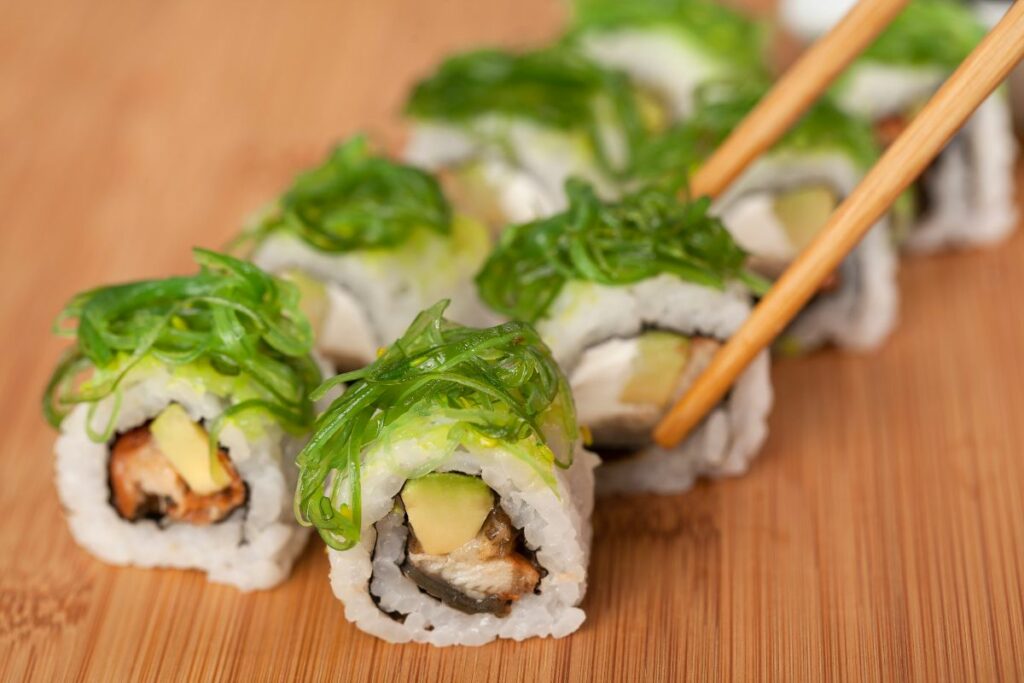
Savoring Seafood Options
Sushi is often associated with raw seafood, making it a popular choice for seafood lovers. Here are some seafood options to savor with your sushi:
- Shrimp: Grilled or tempura shrimp can be a tasty addition to your sushi meal. Shrimp nigiri or sushi rolls with shrimp, avocado, and cucumber can be a great combination.
- Fish: Fresh fish, such as salmon and tuna, can be a delicious pairing with sushi. Sashimi, thinly sliced raw fish, is a great way to enjoy the natural flavor of the fish. If you prefer cooked fish, grilled or baked fish can be a good option.
- Tuna: Tuna is a popular choice for sushi, and for good reason. It has a rich, meaty flavor that pairs well with soy sauce and wasabi. Tuna sashimi or sushi rolls with tuna and avocado can be a great choice.
- Imitation Crab: Imitation crab, made from fish, can be a good option for those who don’t like raw seafood. California rolls, made with imitation crab, avocado, and cucumber, are a popular sushi roll choice.
When it comes to seafood options, it’s important to choose fresh, high-quality seafood to ensure the best flavor and texture. If you’re not sure about the quality of the seafood, it’s best to avoid it.
Overall, sushi can be a great way to enjoy a variety of seafood options. Whether you prefer raw or cooked seafood, there’s a sushi option for you.
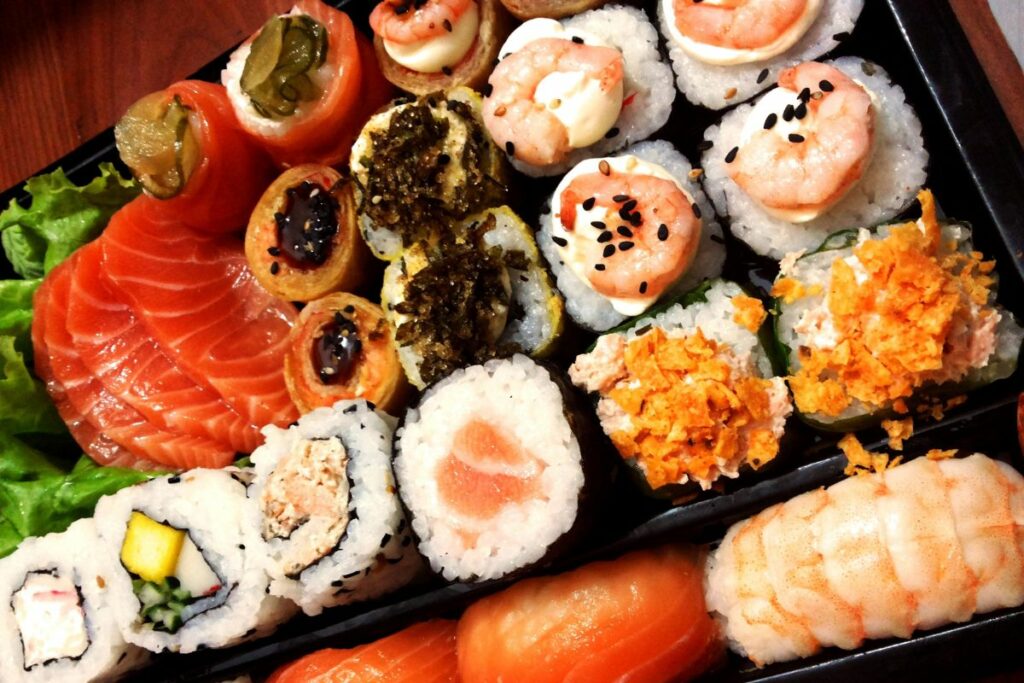
The Importance of Rice
Rice is an essential component of sushi, and it is the foundation upon which all other ingredients are built. The right type of rice is crucial to achieving the perfect sushi experience. Sushi rice, also known as shari, is a short-grain rice that is sticky and slightly sweet when cooked. It is prepared with rice vinegar, sugar, and salt, which gives it its distinct flavor and texture.
The quality of the rice used in sushi is critical. Sushi rice must be of the highest quality to achieve the perfect texture and flavor. The rice should be fresh and free of any impurities. It should also be cooked to perfection to achieve the right texture and stickiness.
Rice vinegar is an essential ingredient in sushi rice. It is used to give the rice its unique flavor and to help it stick together. Rice vinegar is made by fermenting rice, and it has a mild, slightly sweet flavor that complements the other ingredients in sushi.
In summary, the right type of rice, along with the proper preparation and use of rice vinegar, is essential to achieving the perfect sushi experience. The quality of the rice used in sushi is critical, and it should be of the highest quality to achieve the perfect texture and flavor.
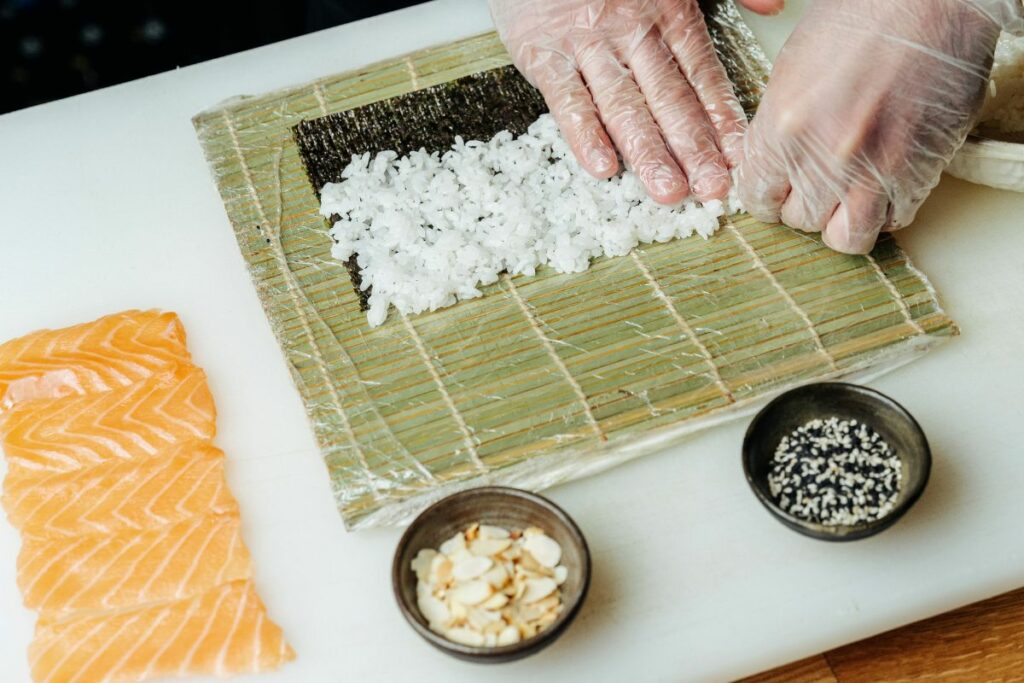
The Art of Japanese Soups
Soup is an essential part of a traditional Japanese meal, and it is no different when it comes to serving sushi. There are two basic types of Japanese soup: suimono or clear soup, and miso soup. Both types of soup have a delicate flavor that complements the taste of sushi perfectly.
Miso soup is made of dashi stock and miso paste. Dashi stock is a broth made from simmering kombu, a type of seaweed, and katsuobushi, dried and smoked bonito fish flakes. Miso paste is made from fermented soybeans and grains, and it has a salty, umami flavor.
The two main solid ingredients in miso soup are tofu and negi or spring onion. The tofu adds a soft texture to the soup, while the negi provides a mild onion flavor. Some variations of miso soup may also include other ingredients like seaweed, mushrooms, or clams.
Suimono, on the other hand, is a clear soup made from dashi stock and soy sauce. It has a more delicate flavor compared to miso soup and is usually served at the beginning of a meal to cleanse the palate. Suimono may also include other ingredients like seafood, vegetables, or tofu.
When serving sushi, it is customary to serve miso soup alongside it. The soup is usually served in a small bowl, and it is sipped directly from the bowl. It is also common to serve pickled ginger, or gari, alongside sushi and soup. The ginger is meant to be eaten in between bites of sushi to cleanse the palate and enhance the flavor of the sushi.
In summary, the art of Japanese soups is an important part of any traditional Japanese meal, including sushi. Miso soup and suimono are two basic types of Japanese soup, each with its unique flavor and ingredients. When serving sushi, it is customary to serve miso soup alongside it, along with pickled ginger to cleanse the palate.
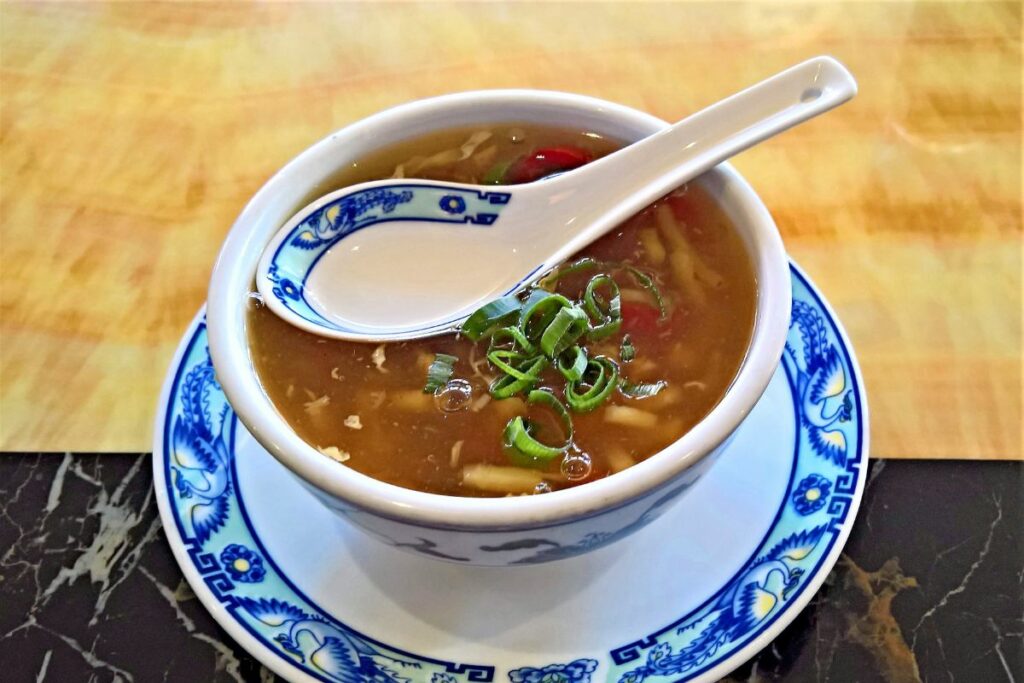
Exploring Japanese Beverages
When it comes to sushi, it’s not just about the food, but also the drinks that accompany it. Japanese beverages have a unique taste and are perfect to pair with sushi. Here are some of the most popular Japanese beverages to try with your sushi:
Sake
Sake is a traditional Japanese rice wine that has been around for centuries. It has a unique flavor and aroma that pairs perfectly with sushi. Sake is served at room temperature or slightly chilled and is available in various grades. The higher the grade, the smoother and more refined the taste.
Green Tea
Green tea is a popular Japanese beverage that is known for its health benefits. It has a light and refreshing taste that complements the flavors of sushi. Green tea is also a great palate cleanser and helps to neutralize the flavors in between bites.
Matcha
Matcha is a type of green tea that is made by grinding green tea leaves into a fine powder. It has a rich and creamy taste and is often used in traditional Japanese tea ceremonies. Matcha is also a great beverage to pair with sushi as it has a strong flavor that can stand up to the bold flavors of sushi.
When it comes to pairing Japanese beverages with sushi, it’s important to choose something that complements the flavors of the food. Sake, green tea, and matcha are all great options that will enhance the taste of your sushi. So, the next time you enjoy sushi, don’t forget to try one of these delicious Japanese beverages.
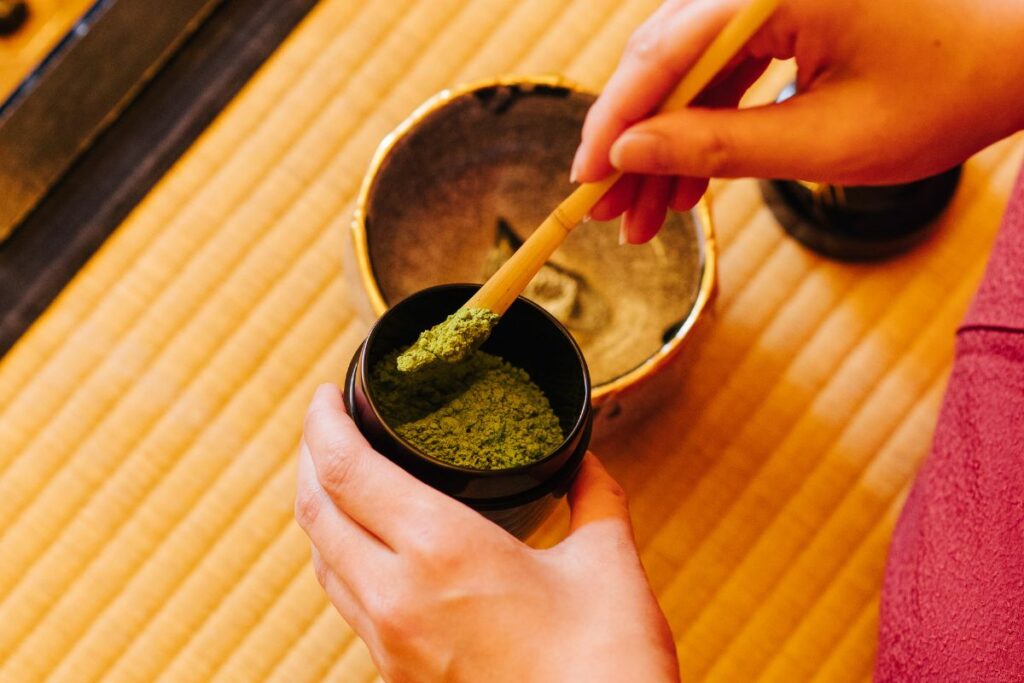
The Sweet Side of Sushi Meals
Sushi is a popular Japanese dish that is enjoyed by many people around the world. It is a versatile dish that can be served as a main course, appetizer, or snack. While sushi is typically served with soy sauce, wasabi, and pickled ginger, it is also common to serve sweet treats with sushi meals.
One popular sweet treat to serve with sushi is matcha ice cream. Matcha is a type of green tea that is finely ground into a powder. It has a unique flavor that is slightly bitter and earthy. Matcha ice cream is a popular dessert in Japan and is often served with sushi meals. The sweetness of the ice cream complements the savory flavors of the sushi, creating a perfect balance of flavors.
Another sweet treat that is commonly served with sushi is dango. Dango is a Japanese sweet made from rice flour. It is typically served on a skewer and can be eaten plain or with a variety of toppings. Some popular toppings for dango include soy sauce, sesame seeds, and red bean paste. Dango is a great option for those who want something sweet but not too heavy.
Red bean paste is another popular sweet that is often served with sushi meals. Red bean paste, also known as anko, is made from azuki beans that have been boiled and mashed with sugar. It has a sweet and nutty flavor that pairs well with the savory flavors of sushi. Red bean paste can be served on its own or used as a filling for mochi or other sweet treats.
Overall, serving sweet treats with sushi meals is a great way to add some variety and balance to the meal. Matcha ice cream, dango, and red bean paste are just a few of the many sweet treats that can be served with sushi. Whether you are a sushi lover or a first-time sushi eater, adding a sweet treat to your meal is sure to enhance your dining experience.

Creating Balanced Flavors
When it comes to serving sushi, creating balanced flavors is crucial to enhancing the overall dining experience. The combination of flavors should complement each other, rather than overpowering one another. Here are some tips to help achieve a balanced flavor profile.
Use Vinegar
Vinegar is a common ingredient in sushi rice, and it adds a tangy flavor that balances the richness of the fish. Rice vinegar is the most commonly used type of vinegar in sushi, but other types like apple cider vinegar can also be used for a unique flavor.
Add Ginger
Pickled ginger, or gari, is often served with sushi to cleanse the palate between bites. It also adds a slightly sweet and spicy flavor that complements the fish. Fresh ginger can also be used in sushi rolls or as a garnish to add a subtle kick of heat.
Incorporate Garlic
Garlic is a versatile ingredient that can be used in various sushi dishes to add depth and complexity to the flavors. It pairs well with soy sauce and can be used in sauces or marinades for an extra burst of flavor.
Use Sugar
A touch of sweetness can balance out the salty and savory flavors in sushi. Sugar can be added to sushi rice, sauces, or marinades to enhance the overall flavor profile.
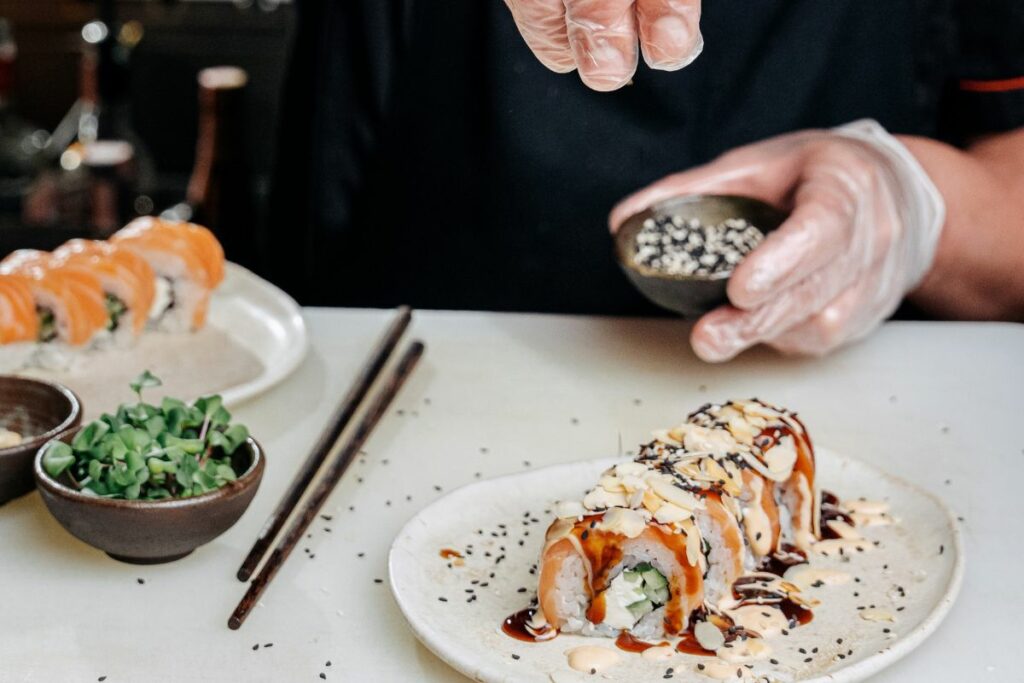
Sprinkle Sesame Seeds
Sesame seeds are a common garnish in sushi dishes, and they add a nutty flavor and crunchy texture. They can be toasted for an even more intense flavor.
Add Chili
Chili adds a spicy kick to sushi dishes and can be used in sauces, marinades, or as a garnish. It pairs well with soy sauce and can be used in moderation to add depth and complexity to the flavors.
Use Salt and Pepper
Salt and pepper are staples in many cuisines, and they can be used in sushi dishes to enhance the overall flavor profile. They should be used in moderation to avoid overpowering the delicate flavors of the fish.
Try Teriyaki Sauce
Teriyaki sauce is a sweet and savory sauce that pairs well with sushi dishes. It can be used as a marinade or a dipping sauce for sushi rolls.
Drizzle Sesame Oil
Sesame oil adds a nutty flavor and aroma to sushi dishes. It can be used in sauces, marinades, or as a finishing touch to enhance the overall flavor profile.
Use Ponzu Sauce
Ponzu sauce is a citrus-based sauce that adds a tangy and refreshing flavor to sushi dishes. It pairs well with seafood and can be used as a dipping sauce or a marinade.

The Use of Tofu in Sushi Meals
Tofu is a versatile ingredient that has been used in Japanese cuisine for centuries. It is a great source of protein and is often used in vegetarian and vegan dishes. When it comes to sushi, tofu can be a great addition to the meal. Here are some ways that tofu can be used in sushi meals:
Tofu Cubes
Tofu cubes are a popular ingredient in sushi rolls. They add a creamy texture to the roll and are a great source of protein. Tofu cubes can be marinated in soy sauce, mirin, and sake to give them a savory flavor. They can also be fried to give them a crispy texture.
Vegan Sushi
Tofu can be used as a substitute for fish in vegan sushi. Vegan sushi rolls can be made with avocado, cucumber, carrots, and tofu. The tofu can be marinated in soy sauce and sesame oil to give it a savory flavor. Vegan sushi is a great option for those who are looking for a healthier alternative to traditional sushi rolls.
Tofu Skin
Tofu skin, also known as yuba, is a thin layer of tofu that is often used in sushi rolls. It has a delicate texture and can be used as a wrapper for the sushi roll. Tofu skin can also be used as a filling for the sushi roll. It can be stuffed with vegetables, tofu cubes, and rice.
In conclusion, tofu is a great addition to sushi meals. It is a great source of protein and can be used in a variety of ways. Whether it is tofu cubes, vegan sushi, or tofu skin, tofu can add a unique flavor and texture to sushi rolls.
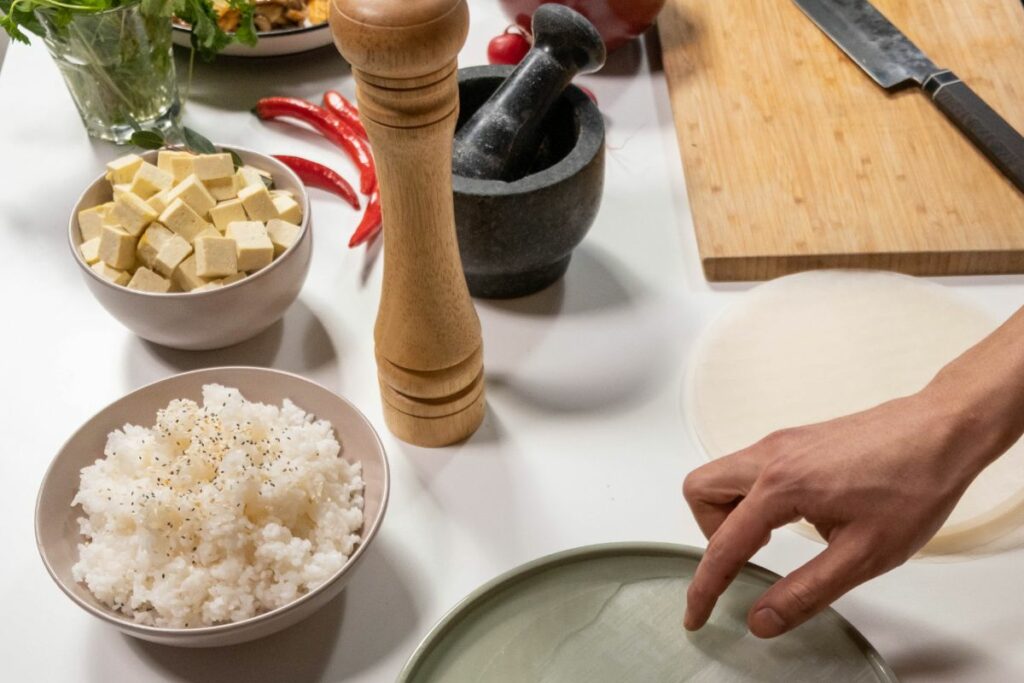
The Role of Eggs in Sushi
Eggs are a common ingredient in sushi, and they add a unique flavor and texture to the dish. There are different types of eggs used in sushi, and each one has its own distinct characteristics.
One of the most popular types of eggs used in sushi is tamagoyaki, which is a sweet omelet made from eggs, sugar, and soy sauce. Tamagoyaki is often used as a filling for sushi rolls, and it adds a sweet and savory flavor to the dish.
Another type of egg commonly used in sushi is fish roe, which comes in different varieties such as tobiko, masago, and ikura. Fish roe adds a burst of flavor and texture to sushi, and it is often used as a topping for nigiri sushi.
Eggplant is not an egg, but it is a popular ingredient in vegetarian sushi rolls. It has a meaty texture and a mild flavor, which makes it a great substitute for meat in sushi rolls.
Overall, eggs play an important role in sushi, adding flavor, texture, and variety to the dish. Whether you prefer tamagoyaki, fish roe, or eggplant in your sushi, there is a wide range of options to choose from.

Exploring Japanese-Inspired Recipes
Japanese cuisine is known for its unique flavors, fresh ingredients, and beautiful presentation. When it comes to serving sushi, it’s important to consider the side dishes that will complement and enhance the flavors of the sushi. While traditional Japanese side dishes like miso soup and pickled ginger are always a great option, there are many other Japanese-inspired recipes that can be served alongside sushi to create a delicious and well-rounded meal.
One popular Japanese-inspired recipe that goes well with sushi is kushiyaki, which are skewered and grilled meats or vegetables. Common kushiyaki ingredients include chicken, beef, pork, shrimp, mushrooms, and green onions. These skewers are often marinated in a sweet and savory sauce before being grilled, giving them a delicious caramelized flavor. Kushiyaki is a great option for those who want to add some protein to their sushi meal or for those who want to try something new.
Another Japanese-inspired recipe that pairs well with sushi is tempura. Tempura is a popular Japanese dish that consists of deep-fried battered seafood or vegetables. The light and crispy texture of tempura complements the soft and delicate texture of sushi, making it a great option for those who want to add some crunch to their meal. Common tempura ingredients include shrimp, squid, sweet potato, and eggplant.
For those who want to add some vegetables to their sushi meal, Japanese-inspired salads are a great option. Cucumber salad, seaweed salad, and carrot salad are all popular Japanese salads that can be served alongside sushi. These salads are often dressed with a light and tangy dressing, making them a refreshing and flavorful addition to any sushi meal.
Overall, there are many Japanese-inspired recipes that can be served alongside sushi to create a delicious and well-rounded meal. Whether you choose to serve kushiyaki, tempura, or a Japanese-inspired salad, these dishes are sure to enhance the flavors of your sushi and create a memorable dining experience.
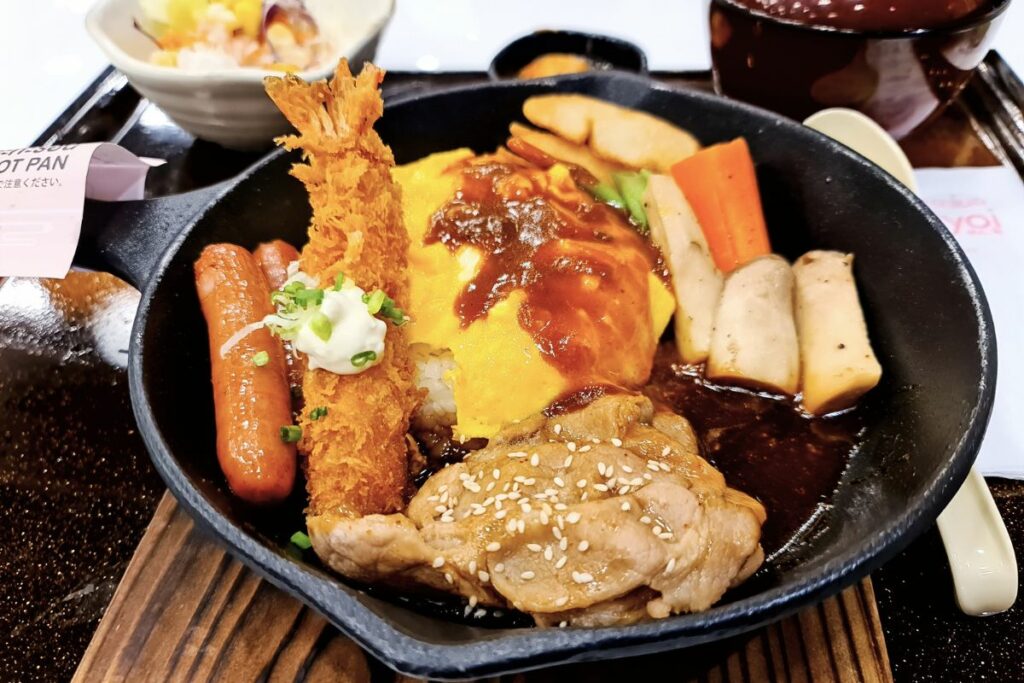
The Importance of Freshness
Freshness is crucial when it comes to sushi. The quality of the ingredients used can make or break the dish. Sushi is all about the balance of flavors and textures, and fresh ingredients play a vital role in achieving that balance.
When sushi is made with fresh ingredients, it not only tastes better, but it is also healthier. Fresh fish is rich in omega-3 fatty acids, which are essential for good health. These fatty acids can help reduce the risk of heart disease, stroke, and other health problems. Fresh vegetables and herbs used in sushi are also packed with essential vitamins and minerals that are beneficial for the body.
Sushi chefs take great care in selecting the freshest ingredients for their dishes. They know that using fresh ingredients is the key to creating a delicious and healthy meal. Fresh fish is carefully inspected for quality and freshness before it is used in sushi. The fish should have a bright, clear eye, firm flesh, and a fresh, ocean-like smell.
It’s important to note that not all sushi restaurants use fresh ingredients. Some may use frozen fish or other ingredients that have been stored for a long time. While frozen fish can still be of good quality, it may not be as flavorful as fresh fish. In some cases, freezing can even enhance the flavor of certain fish, like tuna. However, it’s important to ensure that the fish has been frozen and stored correctly to maintain its quality.
In summary, freshness is essential when it comes to sushi. Fresh ingredients not only taste better but are also healthier. Sushi chefs take great care in selecting the freshest ingredients for their dishes, and customers should choose sushi restaurants that prioritize freshness.
